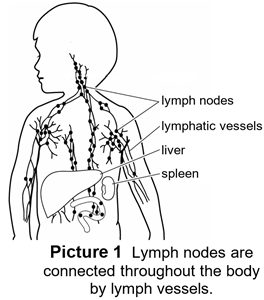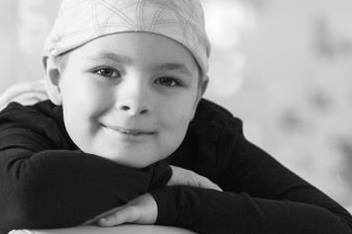Non-Hodgkin Lymphoma

Non-Hodgkin lymphoma (NHL) is a cancerous tumor that starts in the lymphatic tissue in the body. The lymphatic system fights infection and is a part of the circulatory system. It contains hundreds of lymph nodes. One lymph node is about the size of a kidney bean. Nodes are connected by lymph vessels throughout the body (Picture 1).
 Lymph is a clear fluid that carries infection-fighting cells through the nodes and vessels. The lymph nodes make lymphocytes, a type of white blood cell that keeps infections from spreading. They also keep out germs that cause infections.Types of Non-Hodgkin Lymphoma
Lymph is a clear fluid that carries infection-fighting cells through the nodes and vessels. The lymph nodes make lymphocytes, a type of white blood cell that keeps infections from spreading. They also keep out germs that cause infections.Types of Non-Hodgkin Lymphoma
There are 3 major types of pediatric NHL:
- Small B-cell (Burkitt) lymphoma –starts in the abdomen (belly) most of the time
- Lymphoblastic lymphoma – often found in the chest
- Anaplastic large cell lymphoma (ALCL) – found in the lungs, bones, skin, or lymph nodes
Signs and Symptoms
NHL is a disease that usually comes on suddenly and gets worse quickly. Symptoms vary depending on where tumor(s) are. These are the most common locations and their symptoms:
- Abdomen – pain, swelling, fever, anemia, tiredness, weight loss, vomiting, diarrhea, constipation, and irregular periods
- Chest – fever, cough, trouble breathing, chest pain, weight loss, tiredness, night sweats, loss of appetite, vomiting, and nausea
- Spinal area, skin, and bones – pain, numbness or tingling, rash or skin lesions, and problems walking
Diagnosis
A health care provider will examine the lymph node to diagnose non-Hodgkin lymphoma.
- The node, or a small piece of it, is taken out in an operating room. Your child will be under general anesthesia or be sedated. After the node is removed, it is examined. This is a biopsy.
- Once there is a diagnosis, more tests may be ordered. Tests can include: blood tests, MRI, PET and CT scans, chest X-ray, lumbar puncture, or bone marrow biopsy.
Staging
Staging describes how much and where the disease is at the time of diagnosis.
- Stage I (1) – The tumor is only in 1 place:
- One lymph node area or organ, like the tonsils
- One area of a single organ that is not in the chest area or abdomen
- Stage II (2) – Tumor(s) are not in the chest. One of the following applies:
- Only 1 tumor and in the lymph nodes around it.
- In 2 or more places. Both places are either above or below the large, flat muscle that divides the chest and abdomen. This muscle is called the diaphragm.
- Started in the digestive tract. All of it can be taken out with surgery.
- Stage III (3) – Any of the following can apply to the tumor(s):
- Above and below the diaphragm
- Started in the chest
- Started in the abdomen and is too widespread to be taken out with surgery
- Next to the spine and, maybe, other parts of the body
- Stage IV (4) – The cancer has spread outside the lymph nodes to many places in the body. NHL tends to spread to the bone marrow, liver, lungs, and the fluid around the brain.
Treatment
Children with non-Hodgkin lymphoma are treated with chemotherapy to keep cancer cells from spreading to other parts of the body. Chemotherapy drugs move through the body and attack tumor cells that cannot be seen with X-rays. Your child’s oncologist (cancer doctor) will talk to you about the type and length of treatment.
Follow-Up
- Your child will see an oncologist who will monitor their progress. They will also have scans periodically to see how well the treatment is working.
If you have any questions, ask your child’s health care provider.
HH-I-129 6/90, Revised 1/22 Copyright 1990-2022, Nationwide Children’s Hospital


